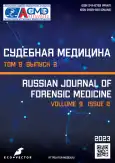A rare case of diaphyseal fractures of the shin bones in a child when jumping on a trampoline. Ways to prevent expert errors using complex analysis of radiography data and case materials: A case report
- Authors: Li Y.B.1,2, Vishniakova M.V.1, Klevno V.А.1
-
Affiliations:
- Moscow Regional Research Clinical Institute
- Primorsky Regional Bureau of Forensic Medical Examination
- Issue: Vol 9, No 2 (2023)
- Pages: 193-199
- Section: Case reports
- URL: https://journals.rcsi.science/2411-8729/article/view/133098
- DOI: https://doi.org/10.17816/fm5955
- ID: 133098
Cite item
Full Text
Abstract
Given the importance of childhood injuries in the structure of common problems associated with children’s health, it is important to determine the exact mechanism of fractures, particularly diaphyseal fractures of the shin bones, during the examination because the specification of the mechanism for the formation of bodily injuries leads to the actual origins of injuries and allows further development of a set of preventive measures to prevent the occurrence of these situations. Moreover, it sometimes allows the defendants to accurately distribute the burden of responsibility for what happened.
In the presented expert case, the circumstances of bodily injury described by the subject and her legal representative were inconsistent with the type and nature of fractures received while trampoline jumping and the video recording from the surveillance camera did not provide complete information about the specific conditions of injury. A detailed analysis of the results of shin bone radiography, including determining the morphological features of fractures and their nature, and a frame-by-frame study of the presented video recording.
The diaphyseal fractures of the shin bones of atypical localization for a “trampoline injury” detected in a child could serve as a source of expert errors in determining the mechanism of their occurrence; however, a thorough, comprehensive assessment of all objects for examination, such as medical documents, including X-ray data and case materials, taking into account the age-specific morphology of the bone tissue of the child, enables to determine the exact mechanism of the occurrence of fractures.
Keywords
Full Text
##article.viewOnOriginalSite##About the authors
Yulia B. Li
Moscow Regional Research Clinical Institute; Primorsky Regional Bureau of Forensic Medical Examination
Author for correspondence.
Email: reineerdeluft@gmail.com
ORCID iD: 0000-0001-7870-5746
SPIN-code: 2397-7425
MD
Russian Federation, Moscow; VladivostokMarina V. Vishniakova
Moscow Regional Research Clinical Institute
Email: cherridra@mail.ru
ORCID iD: 0000-0003-3838-636X
SPIN-code: 1137-2991
MD, Dr. Sci. (Med.)
Russian Federation, MoscowVladimir А. Klevno
Moscow Regional Research Clinical Institute
Email: vladimir.klevno@yandex.ru
ORCID iD: 0000-0001-5693-4054
SPIN-code: 2015-6548
MD, Dr. Sci. (Med.), Professor
Russian Federation, MoscowReferences
- Zdravookhranenie v Rossii. 2021: Statisticheskii sbornik. Moscow; 2021. 171 p. (In Russ).
- Mironov SP, editor. Injuries, orthopedic morbidity, the state of traumatological and orthopedic care for the population of Russia in 2015. Moscow; 2016. 145 p. (In Russ).
- Solovieva KS, Zaletina AV. Injuries in the children’s population of St. Petersburg. Orthopedics, Traumatology and Reconstructive Surgery of Children. 2017;5(3):43–48. (In Russ). doi: 10.17816/PTORS5343-49
- Kuptsova OA, Zaletina AV, Vissarionov SV, et al. Injury rates in children during the period of restrictive measures associated with the spread of a new coronavirus infection (COVID-19). Pediatric Orthopedics, Traumatology and Reconstructive Surgery. 2021;9(1):5–16. (In Russ). doi: 10.17816/PTORS58630
- Baindurashvili AG, Shapiro KI, Drozhzhina LA, Vishnyakov AN. Indicators and dynamics of injuries of the musculoskeletal system in children of St. Petersburg in modern conditions. Pediatrician. 2016; 7(2):113–120. (In Russ).
- Köhncke S. Frakturen der langen Röhrenknochen bei Kindern — Erhebung epidemiologischer Daten und Vergleich von vier Frakturklassifikationen [dissertation]. Kiel, 2011. (In German).
- Illian C, Veigel B, Chylarecki C. Osteosyntheseverfahren in der Kinder- und Jugendtraumatologie. OUP. 2013;12:578–583. (In German). doi: 10.3238/oup.2013.0578–0583
- Merkulov VN, Dorokhin AI, Bukhtin KM. Pediatric traumatology. Mironov SP, editor. Moscow: GEOTAR-Media, 2019. 256 p. (In Russ).
- Abdulkhabirov MA. Fractures and dislocations in children (clinical lecture) [Internet]. Difficult patient [cited 2023 Apr 22]. Available from: https://t-pacient.ru/articles/209/
- Rozinov VM, Yandiev SI, Kolyagin DV. Medical technologies for the treatment of children with diaphyseal fractures of the tibia // Russian Journal of Pediatric Surgery, Anesthesia and Intensive Care. 2016. Т. VI, № 3. С. 118–125. (In Russ).
- Dorokhin AI, Krupatkin AI, Adrianova AA, et al. Closed fractures of the distal leg bones. Variety of forms and treatment (on the example of older age groups). Immediate results // Physical and rehabilitation medicine, medical rehabilitation. 2021;3(1):11–23. (In Russ). doi: 10.36425/rehab63615
Supplementary files








